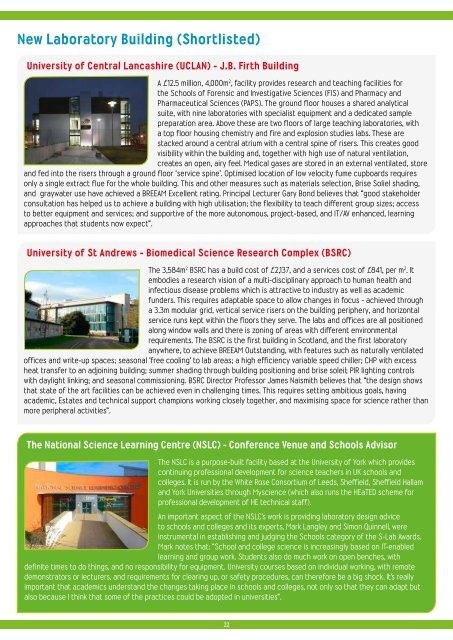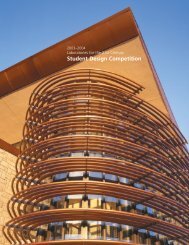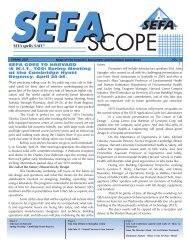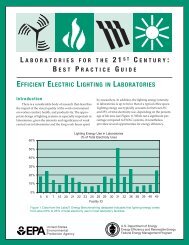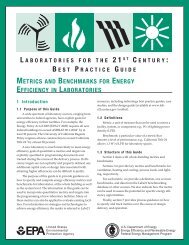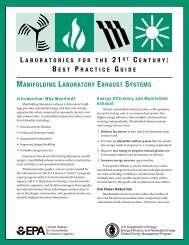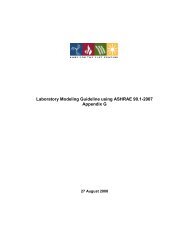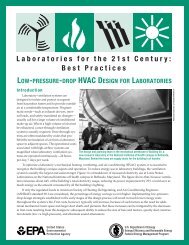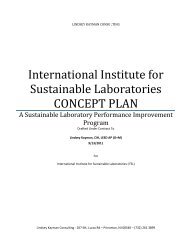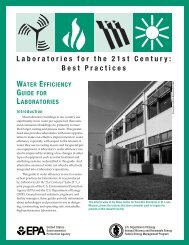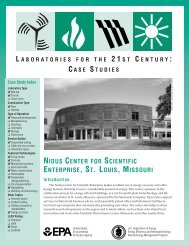Results of the 2012 S-Lab Awards and Conference The Effective ...
Results of the 2012 S-Lab Awards and Conference The Effective ...
Results of the 2012 S-Lab Awards and Conference The Effective ...
You also want an ePaper? Increase the reach of your titles
YUMPU automatically turns print PDFs into web optimized ePapers that Google loves.
New <strong>Lab</strong>oratory Building (Shortlisted)<br />
University <strong>of</strong> Central Lancashire (UCLAN) - J.B. Firth Building<br />
A £12.5 million, 4,000m 2 , facility provides research <strong>and</strong> teaching facilities for<br />
<strong>the</strong> Schools <strong>of</strong> Forensic <strong>and</strong> Investigative Sciences (FIS) <strong>and</strong> Pharmacy <strong>and</strong><br />
Pharmaceutical Sciences (PAPS). <strong>The</strong> ground floor houses a shared analytical<br />
suite, with nine laboratories with specialist equipment <strong>and</strong> a dedicated sample<br />
preparation area. Above <strong>the</strong>se are two floors <strong>of</strong> large teaching laboratories, with<br />
a top floor housing chemistry <strong>and</strong> fire <strong>and</strong> explosion studies labs. <strong>The</strong>se are<br />
stacked around a central atrium with a central spine <strong>of</strong> risers. This creates good<br />
visibility within <strong>the</strong> building <strong>and</strong>, toge<strong>the</strong>r with high use <strong>of</strong> natural ventilation,<br />
creates an open, airy feel. Medical gases are stored in an external ventilated, store<br />
<strong>and</strong> fed into <strong>the</strong> risers through a ground floor ‘service spine’. Optimised location <strong>of</strong> low velocity fume cupboards requires<br />
only a single extract flue for <strong>the</strong> whole building. This <strong>and</strong> o<strong>the</strong>r measures such as materials selection, Brise Soliel shading,<br />
<strong>and</strong> graywater use have achieved a BREEAM Excellent rating. Principal Lecturer Gary Bond believes that “good stakeholder<br />
consultation has helped us to achieve a building with high utilisation; <strong>the</strong> flexibility to teach different group sizes; access<br />
to better equipment <strong>and</strong> services; <strong>and</strong> supportive <strong>of</strong> <strong>the</strong> more autonomous, project-based, <strong>and</strong> IT/AV enhanced, learning<br />
approaches that students now expect”.<br />
University <strong>of</strong> St Andrews - Biomedical Science Research Complex (BSRC)<br />
<strong>The</strong> 3,584m 2 BSRC has a build cost <strong>of</strong> £2,137, <strong>and</strong> a services cost <strong>of</strong> £841, per m 2 . It<br />
embodies a research vision <strong>of</strong> a multi-disciplinary approach to human health <strong>and</strong><br />
infectious disease problems which is attractive to industry as well as academic<br />
funders. This requires adaptable space to allow changes in focus - achieved through<br />
a 3.3m modular grid, vertical service risers on <strong>the</strong> building periphery, <strong>and</strong> horizontal<br />
service runs kept within <strong>the</strong> floors <strong>the</strong>y serve. <strong>The</strong> labs <strong>and</strong> <strong>of</strong>fices are all positioned<br />
along window walls <strong>and</strong> <strong>the</strong>re is zoning <strong>of</strong> areas with different environmental<br />
requirements. <strong>The</strong> BSRC is <strong>the</strong> first building in Scotl<strong>and</strong>, <strong>and</strong> <strong>the</strong> first laboratory<br />
anywhere, to achieve BREEAM Outst<strong>and</strong>ing, with features such as naturally ventilated<br />
<strong>of</strong>fices <strong>and</strong> write-up spaces; seasonal ‘free cooling’ to lab areas; a high efficiency variable speed chiller; CHP with excess<br />
heat transfer to an adjoining building; summer shading through building positioning <strong>and</strong> brise soleil; PIR lighting controls<br />
with daylight linking; <strong>and</strong> seasonal commissioning. BSRC Director Pr<strong>of</strong>essor James Naismith believes that “<strong>the</strong> design shows<br />
that state <strong>of</strong> <strong>the</strong> art facilities can be achieved even in challenging times. This requires setting ambitious goals, having<br />
academic, Estates <strong>and</strong> technical support champions working closely toge<strong>the</strong>r, <strong>and</strong> maximising space for science ra<strong>the</strong>r than<br />
more peripheral activities”.<br />
<strong>The</strong> National Science Learning Centre (NSLC) - <strong>Conference</strong> Venue <strong>and</strong> Schools Advisor<br />
<strong>The</strong> NSLC is a purpose-built facility based at <strong>the</strong> University <strong>of</strong> York which provides<br />
continuing pr<strong>of</strong>essional development for science teachers in UK schools <strong>and</strong><br />
colleges. It is run by <strong>the</strong> White Rose Consortium <strong>of</strong> Leeds, Sheffield, Sheffield Hallam<br />
<strong>and</strong> York Universities through Myscience (which also runs <strong>the</strong> HEaTED scheme for<br />
pr<strong>of</strong>essional development <strong>of</strong> HE technical staff).<br />
An important aspect <strong>of</strong> <strong>the</strong> NSLC’s work is providing laboratory design advice<br />
to schools <strong>and</strong> colleges <strong>and</strong> its experts, Mark Langley <strong>and</strong> Simon Quinnell, were<br />
instrumental in establishing <strong>and</strong> judging <strong>the</strong> Schools category <strong>of</strong> <strong>the</strong> S-<strong>Lab</strong> <strong>Awards</strong>.<br />
Mark notes that: “School <strong>and</strong> college science is increasingly based on IT-enabled<br />
learning <strong>and</strong> group work. Students also do much work on open benches, with<br />
definite times to do things, <strong>and</strong> no responsibility for equipment. University courses based on individual working, with remote<br />
demonstrators or lecturers, <strong>and</strong> requirements for clearing up, or safety procedures, can <strong>the</strong>refore be a big shock. It’s really<br />
important that academics underst<strong>and</strong> <strong>the</strong> changes taking place in schools <strong>and</strong> colleges, not only so that <strong>the</strong>y can adapt but<br />
also because I think that some <strong>of</strong> <strong>the</strong> practices could be adopted in universities”.<br />
22


